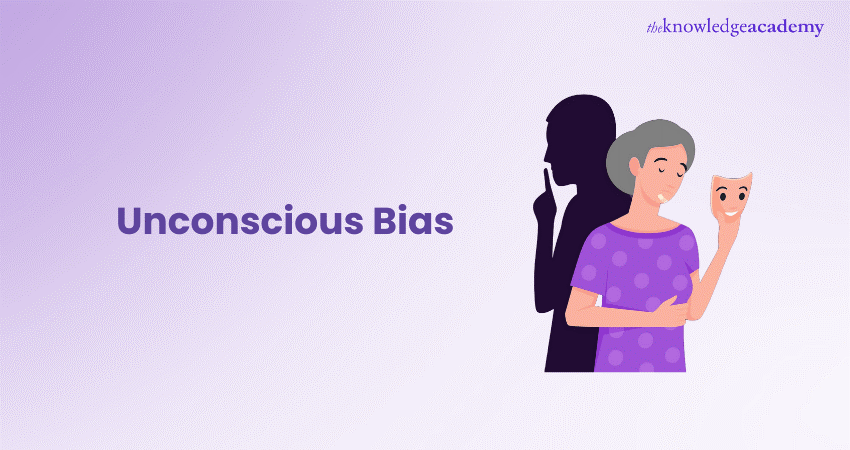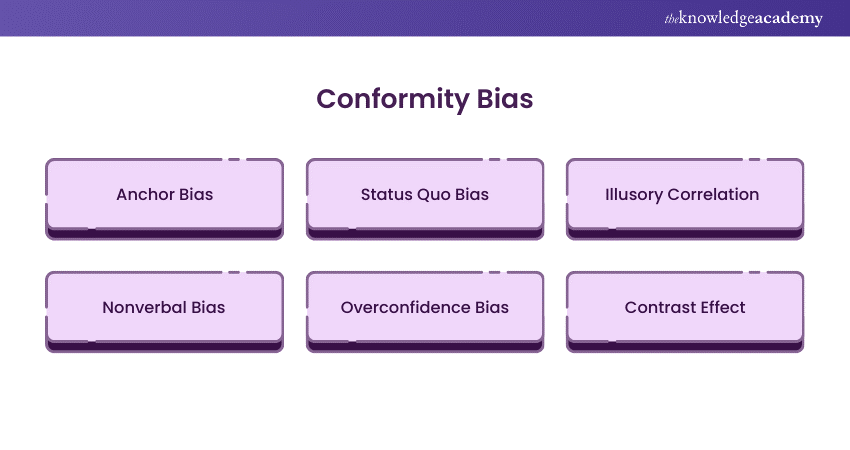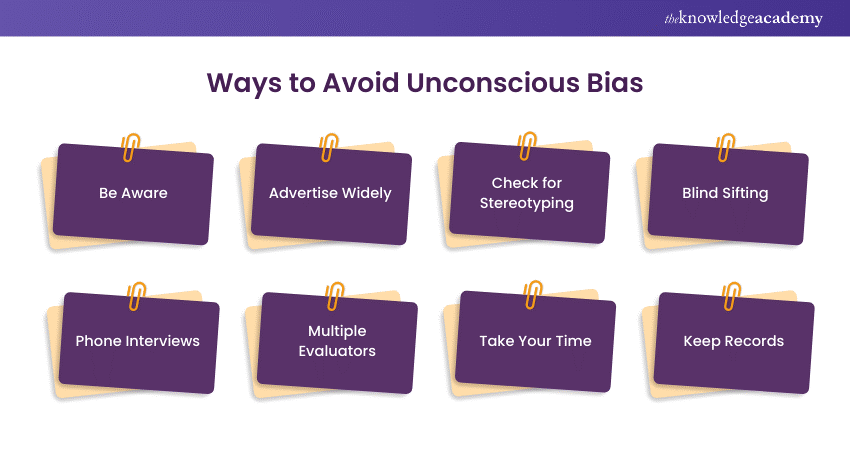We may not have the course you’re looking for. If you enquire or give us a call on +43 720 115337 and speak to our training experts, we may still be able to help with your training requirements.
We ensure quality, budget-alignment, and timely delivery by our expert instructors.

We all make snap judgments without even realising it—this is known as Unconscious Bias. These biases subtly influence our behaviour and decisions, often stemming from societal norms and personal experiences. They shape how we perceive others based on factors like race, gender, age, or appearance.
Unchecked, Unconscious Bias can lead to unintended discrimination and hinder workplace diversity and inclusion. By recognising and understanding these biases, we can actively challenge them, fostering more inclusive environments. Ready to start your journey to uncover and address Unconscious Bias? Keep reading this blog to learn more!
Table of Contents
1) What is Unconscious Bias?
2) 18 Examples of Unconscious Bias
a) Gender Bias
b) Affinity Bias
c) Beauty Bias
d) Authority Bias
e) Ageism
f) Name Bias
g) Height Bias
h) Attribution Bias
i) Halo Effect
j) Horn Effect
3) Ways to Avoid Unconscious Bias
4) Conclusion
What is Unconscious Bias?
Unconscious Bias, also known as Implicit Bias, refers to the learned beliefs or attitudes that reside in our subconscious. These biases, which everyone possesses, serve as mental shortcuts to help us process information quickly.
Implicit biases develop over time through our life experiences and exposure to stereotypes. They can be either positive or negative and are activated without our conscious awareness or control. These biases significantly influence our beliefs and behaviours, especially in professional settings, where they can impact hiring decisions, interactions with colleagues, and overall business decisions.
If left unaddressed, Unconscious Biases can damage a company’s culture and team dynamics. However, their impact can be mitigated with deliberate effort. By becoming aware of and understanding different types of biases, we can take steps to combat them.
Key Points:
a) Development: Formed through life experiences and exposure to stereotypes.
b) Activation: Triggered without conscious awareness or control.
c) Impact: Influences beliefs and behaviours, affecting hiring, colleague interactions, and business decisions.
d) Consequences: Can harm company culture and team dynamics if not addressed.
e) Mitigation: Awareness and understanding of biases are crucial for reducing their impact.
18 Examples of Unconscious Bias
There are different types of Unconscious Biases that have various effects. Here are common biases and how to avoid them:
1) Gender Bias
Gender Bias is also known as Sexism. It is the preference for one gender over another. This bias happens when people unconsciously link certain stereotypes with different genders.
Gender Bias can impact hiring practices and workplace relationships. For example, a hiring panel might prefer male applicants over female applicants, even if they have the same or similar skills and experience.
Gender Bias can limit job and career advancement opportunities for some groups. Here are some ways to create a more gender-diverse workplace:
a) Set Gender-neutral Recruitment Standards: Define the ideal candidate profile in advance and evaluate all candidates against these standards.
b) Create Diversity Goals: Set specific gender diversity goals to build a more balanced team. Provide support and resources for women to take on leadership roles.
2) Affinity Bias
Affinity Bias is also called Similarity Bias. It is the tendency to favour people who share similar interests, backgrounds, and experiences. We feel more comfortable around people who are like us.
This bias can affect hiring decisions. For example, a hiring manager might prefer a job applicant because they went to the same school. Over time, Affinity Bias in hiring can hurt a company’s diversity and inclusion efforts. It may not be possible to eliminate affinity Bias completely. However, there are ways to reduce its impact:
a) Create a Diverse Hiring Panel: Having interviewers with different perspectives and interests can help reduce the bias of any one person.
b) Go Beyond Hiring for “Culture Fit”: Hiring managers often favour candidates they have things in common with, calling it a “culture fit.” However, this term is vague and can mean different things to different people. To assess candidates fairly, use specific language and examples when giving feedback. Describe how well they embody company values or align with the company’s mission.
3) Beauty Bias
Beauty Bias is a social behaviour where people think attractive individuals are more successful, competent, and qualified. Although appearance (excluding race) is not protected by the Equal Employment Opportunity Commission, Beauty Bias is common in the workplace.
Many people link conventional beauty to higher intelligence, social skills, and physical health. Attractive workers can earn more than less attractive workers. However, attractive candidates might also face discrimination from hiring teams due to perceived entitlement. To reduce Beauty Bias, companies should:
a) Create Structured Recruiting and Interview Processes: This helps teams compare applications and interviews fairly.
b) Use Phone Screenings Instead of Video Calls: This can help reduce bias based on appearance.
c) Implement Unbiased Technologies: These tools can help identify top candidates without bias.
4) Authority Bias
Authority Bias is the tendency to believe and follow authority figures without questions. While trusting experts is often beneficial, blindly following instructions can lead to problems.
For example, imagine a team member following the instructions of their manager without question. In this case, the report might reflect the manager’s opinions rather than accurate information. To avoid Authority Bias:
a) Ask Questions: Don’t hesitate to ask your manager for more details. This can help you understand if their idea is well thought-out or just based on their authority.
b) Do Your Research: Look up information from other credible sources to see if they support your manager’s suggestions.
Being aware of Authority Bias is the first step in countering it.
5) Ageism
Ageism is when people stereotype or discriminate against others based on their age, often affecting older workers. Even though workers aged 40 and older are protected by the Age Discrimination in Employment Act, filing a lawsuit for age discrimination can be long and costly. As a result, age discrimination remains common.
For example, an older team member might be passed over for a promotion in favour of a younger, less experienced colleague. This can cause companies to miss out on the valuable knowledge and experience older workers bring, which may lead to legal issues if a discrimination lawsuit is filed. To prevent Ageism:
a) Avoid Assumptions Based on Age: Don’t assume older workers can’t use technology or aren’t willing to learn new skills. Offer equal learning opportunities to everyone.
b) Encourage Cross-generational Collaboration: Set up mentorship programs where senior team members are paired with new hires. This helps break down age-related stereotypes and fosters better and more effective communication.
6) Name Bias
Name Bias is when people judge and prefer others based on their names, often favouring Anglo names. This bias is common in hiring. Studies show that white names get more interview callbacks than Black names. They say that Asian last names are 28% less likely to get a callback than Anglo last names. To avoid Name Bias:
a) Omit Personal Details: Remove the candidate’s name, email, phone number, and address from their application.
b) Assign Numbers: Give candidates a number instead of using their names.
c) Use an Unbiased Team Member: Have an unbiased third-party team member remove personal information before the hiring team reviews applications.
Learn Lifesaving Skills and Create a Safer Work Environment with our Certified Advanced First Aid Training – Join today!
7) Height Bias
Height Bias, or Heightism, is the tendency to judge people based on their height. Studies show that taller individuals can earn more annually for each additional centimetre in height.
Tall candidates are often seen as more competent, employable, and healthy. To avoid Height Bias:
a) Conduct Anonymous Interviews: Use phone or video interviews to reduce the chance of judging someone based on their height.
b) Be Aware of the Bias: Simply knowing that Height Bias is common can help you recognise and counteract it.
8) Attribution Bias
Attribution bias happens when we think someone’s behaviour is due to their character, not outside factors. For example, if a colleague is late, someone might think they are lazy instead of considering that traffic might have been bad.
This bias can cause misunderstandings and wrong judgments about others. To avoid Attribution bias:
a) Think About External Factors: Consider possible outside reasons for someone’s actions before making conclusions.
b) Ask Questions: Ask the person directly about the situation to understand the context better instead of assuming.
9) Halo Effect
The Halo Effect occurs when one person's positive trait influences our overall opinion of them. For example, if someone is very good-looking, you might think they are also smart or capable. This bias can lead to overestimating someone’s abilities based on just one trait. To avoid the Halo Effect:
a) Focus on Facts: Make decisions based on objective performance data, not looks or personal traits.
b) Evaluate Multiple Traits: Assess people based on various criteria, not just one standout quality.
10) Horn Effect
The Horn Effect is the opposite of the Halo Effect. It happens when one negative trait makes us form a poor overall impression of someone. For example, if someone is late for a meeting, you might think they are careless or unprofessional in all areas. To avoid the Horn Effect:
a) Separate the Incident from the Person: Don’t let one negative trait or action affect your judgment of the person’s overall abilities.
b) Gather Multiple Perspectives: Get feedback from others to have a well-rounded view of the individual.
11) Confirmation Bias
Confirmation Bias is when we look for information that supports our existing beliefs and ignore information that contradicts them. For example, if you think remote workers are less productive, you might only notice instances that confirm this view. To avoid confirmation bias:
a) Challenge Your Assumptions: Actively seek out information or opinions that go against your beliefs.
b) Use Objective Data: Make decisions based on evidence and data, not personal opinions or selective information.
12) Conformity Bias
Conformity Bias is when people change their opinions or behaviours to match the majority, even if they disagree. This can lead to poor decisions in groups because people want to fit in rather than share their true thoughts. To avoid conformity bias:

Encourage Independent Thinking: Create a safe space for people to express different opinions without judgment.
Rotate Meeting Leadership: Let different team members lead discussions to reduce the influence of dominant voices.
Do you want to step up as a Safety Leader? Sign up for our Fire Marshal Training and safeguard your team with expert knowledge.
13) Anchor Bias
Anchor Bias happens when people depend too much on the first piece of information they get. This first piece of information is called the “anchor.” For example, in salary talks, the first number mentioned can greatly influence the final agreement, even if it’s not suitable. Here are ways to avoid Anchor Bias:
a) Consider Multiple Options: Look at different pieces of information and viewpoints before deciding.
b) Delay Initial Judgment: Take your time and avoid making quick conclusions based on the first information you receive.
14) Status Quo Bias
Status Quo Bias means preferring to keep things the same instead of making changes, even if changes could be good. For example, a company might not want to use new technologies because they are comfortable with their current methods. Here are ways to avoid Status Quo Bias:
a) Evaluate Risks and Benefits: Regularly check if staying the same is really the best choice or if changes could make things better.
b) Encourage Innovation: Create a culture that welcomes trying new things and being open to new ideas.
15) Illusory Correlation
Illusory Correlation happens when people wrongly think there is a link between two unrelated things. For example, believing that a full moon causes strange behaviour is an example of this bias. This can lead to bad decisions by assuming connections that don’t exist. Here are ways to avoid Illusory Correlation:
a) Rely on Data, Not Assumptions: Make decisions based on real evidence, not on what you think you see.
b) Examine Cause and Effect: Always check if there is a logical link between two things before assuming they are connected.
16) Nonverbal Bias
Nonverbal Bias happens when people judge someone based on their body language, facial expressions, or other nonverbal signals. For example, someone who avoids eye contact might be seen as dishonest, even if that’s not true. Here are ways to avoid Nonverbal Bias:
a) Focus on Content, Not Cues: Listen to what the person is saying, not how they say it.
b) Be Aware of Cultural Differences: Understand that nonverbal communication can be different in various cultures and may not always mean the same thing.
17) Overconfidence Bias
Overconfidence Bias happens when people think they are better or more accurate than they really are. This can lead to taking unnecessary risks or making bad decisions. For example, an overconfident investor might ignore market trends, thinking they know better. Here are ways to avoid Overconfidence Bias:
a) Seek Feedback: Regularly ask others for their opinions to keep your confidence in check and get a balanced view.
b) Review Past Decisions: Look at your previous decisions to spot overconfidence and learn from any mistakes.
18) Contrast Effect
The Contrast Effect occurs when we compare two things. This makes their differences seem bigger than they are. For example, a job candidate might look more qualified if interviewed after a weaker candidate, even if their qualifications are just average. To avoid the Contrast Effect:
a) Evaluate Individually: Look at each person or situation on its own without comparing them to others.
b) Standardise Evaluation Criteria: Use the same standards to judge everyone fairly, without letting comparisons influence your decision.
Prioritise safety at work! Join our Health & Safety in the Workplace Courses to protect your team and comply with regulations.
Ways to Avoid Unconscious Bias
Here are ways to avoid Unconscious Bias at work:

a) Be Aware: Understand that Unconscious Bias exists.
b) Advertise Widely: Post job vacancies in at least two different places to reach diverse candidates.
c) Check for Stereotyping: Recruiting managers should remind each other if they notice any stereotyping.
d) Blind Sifting: Remove details like names or gender from job applications to prevent bias.
e) Phone Interviews: Have one interviewer on the phone to avoid decisions based on appearance.
f) Multiple Evaluators: Use more than one person to sift applications, conduct interviews, and make hiring decisions.
g) Take Your Time: Allow enough time to make decisions on recruitment, promotions, or disciplinary actions.
h) Keep Records: Write down the reasons for each decision.
Conclusion
Unconscious Bias refers to the automatic judgments and assumptions we make about people based on stereotypes without realising it. These biases can affect decisions and interactions in daily life. Understanding and addressing them is important for creating fair and inclusive environments in the workplace and society.
Enhance inclusivity with our Unconscious Bias Training - Empower your team to create a fairer workplace.
Frequently Asked Questions
How Does Unconscious Bias Affect Customer Interactions and Service?

Unconscious Bias can lead to unfair treatment, miscommunication, and reduced customer satisfaction. It can affect service quality and damage brand reputation.
Can Unconscious Bias be Reduced or Managed?

Bias can be managed through continuous training, self-awareness, and inclusive practices. Encourage diverse interactions and use data-driven decisions to minimise bias.
What are the Other Resources and Offers Provided by The Knowledge Academy?

The Knowledge Academy takes global learning to new heights, offering over 30,000 online courses across 490+ locations in 220 countries. This expansive reach ensures accessibility and convenience for learners worldwide.
Alongside our diverse Online Course Catalogue, encompassing 19 major categories, we go the extra mile by providing a plethora of free educational Online Resources like News updates, Blogs, videos, webinars, and interview questions. Tailoring learning experiences further, professionals can maximise value with customisable Course Bundles of TKA.
What is The Knowledge Pass, and How Does it Work?

The Knowledge Academy’s Knowledge Pass, a prepaid voucher, adds another layer of flexibility, allowing course bookings over a 12-month period. Join us on a journey where education knows no bounds.
What are the Related Courses and Blogs Provided by The Knowledge Academy?

The Knowledge Academy offers various Health & Safety in the Workplace Courses, including Unconscious Bias Training, First Aid at Work and Manual Handling at Work. These courses cater to different skill levels, providing comprehensive insights into Who is Responsible for Workplace Health and Safety.
Our Health & Safety Blogs cover a range of topics related to Unconscious Bias, offering valuable resources, best practices, and industry insights. Whether you are a beginner or looking to advance your Health & Safety Skills, The Knowledge Academy's diverse courses and informative blogs have you covered.
Upcoming Health & Safety Resources Batches & Dates
Date
 Unconscious Bias Training Course
Unconscious Bias Training Course
Fri 2nd May 2025
Fri 4th Jul 2025
Fri 5th Sep 2025
Fri 7th Nov 2025






 Top Rated Course
Top Rated Course



 If you wish to make any changes to your course, please
If you wish to make any changes to your course, please


